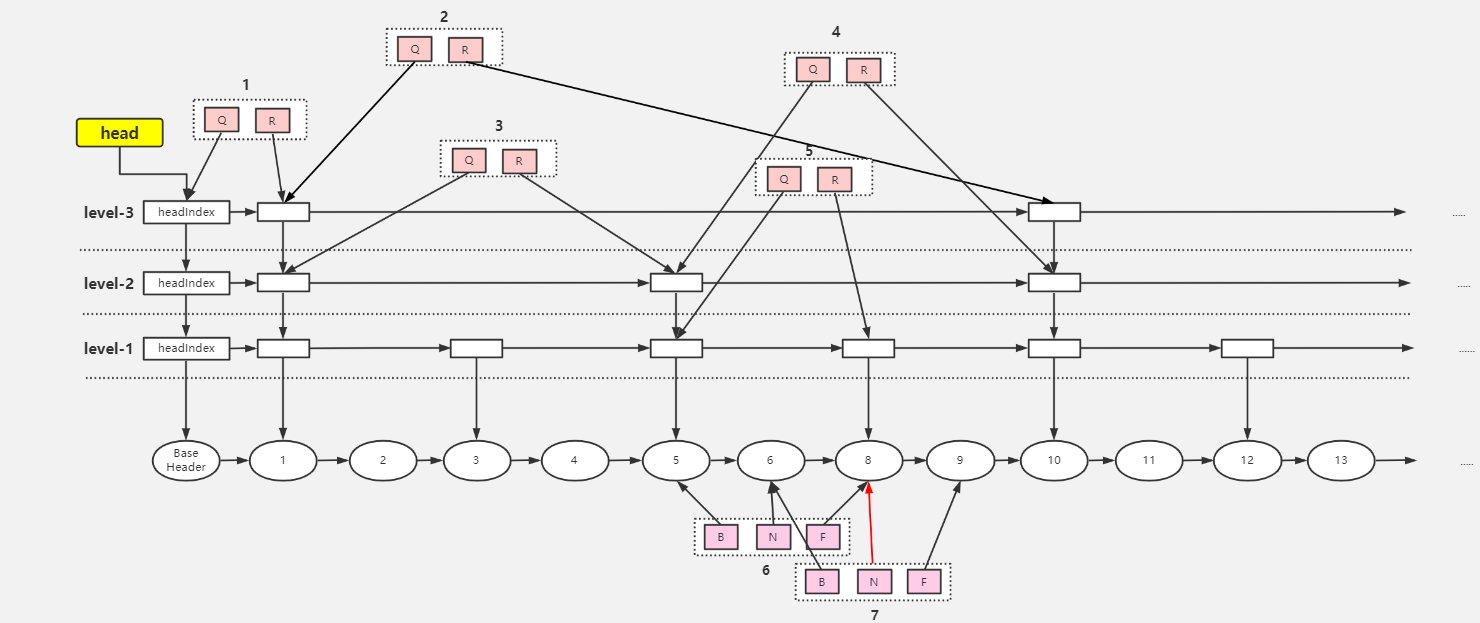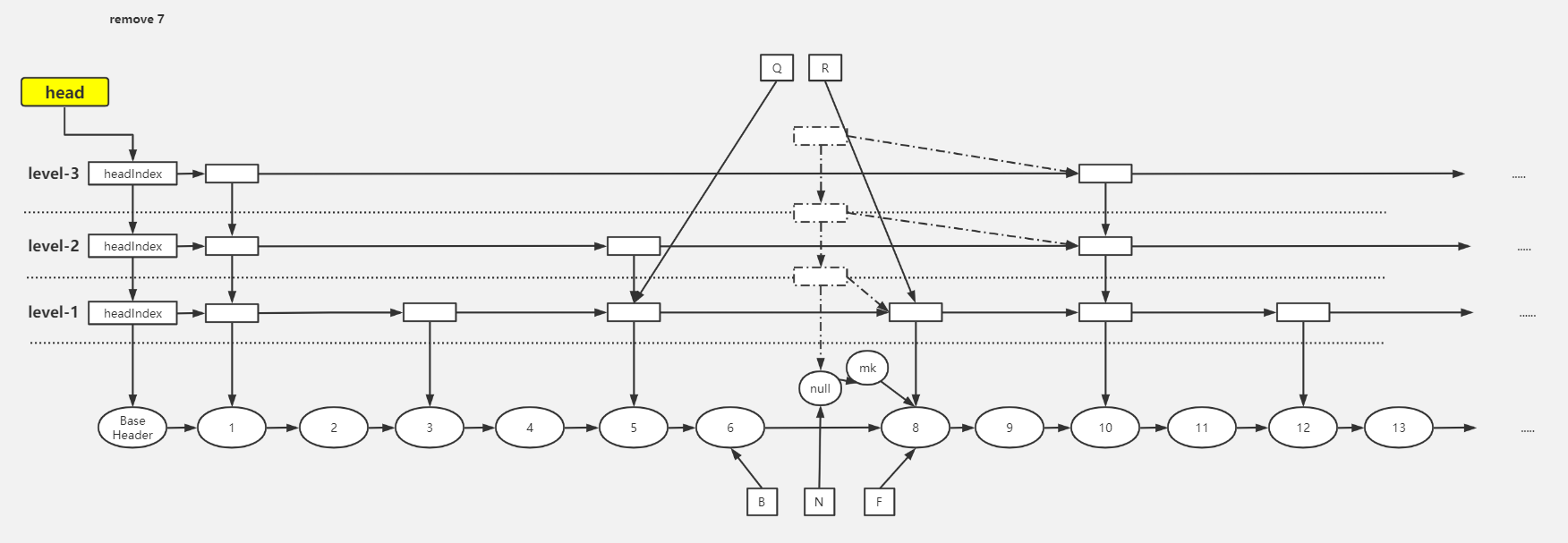文
章
目
录
章
目
录
Collections
Collections类是用来操作集合的工具类,提供了集合转换成线程安全的方法:
public static <T> Collection<T> synchronizedCollection(Collection<T> c) {
return new SynchronizedCollection<>(c);
}
public static <K,V> Map<K,V> synchronizedMap(Map<K,V> m) {
return new SynchronizedMap<>(m);
}
源码:底层也是对方法进行加锁
public boolean add(E e) {
synchronized (mutex) {return c.add(e);}
}
SkipListMap
底层结构
跳表 SkipList 是一个有序的链表,默认升序,底层是链表加多级索引的结构。跳表可以对元素进行快速查询,类似于平衡树,是一种利用空间换时间的算法
对于单链表,即使链表是有序的,如果查找数据也只能从头到尾遍历链表,所以采用链表上建索引的方式提高效率,跳表的查询时间复杂度是 O(logn),空间复杂度 O(n)
ConcurrentSkipListMap 提供了一种线程安全的并发访问的排序映射表,内部是跳表结构实现,通过 CAS + volatile 保证线程安全
平衡树和跳表的区别:
- 对平衡树的插入和删除往往很可能导致平衡树进行一次全局的调整;而对跳表的插入和删除,只需要对整个结构的局部进行操作
- 在高并发的情况下,保证整个平衡树的线程安全需要一个全局锁;对于跳表则只需要部分锁,拥有更好的性能

BaseHeader 存储数据,headIndex 存储索引,纵向上所有索引都指向链表最下面的节点
成员变量
- 标识索引头节点位置
private static final Object BASE_HEADER = new Object(); - 跳表的顶层索引
private transient volatile HeadIndex<K,V> head; - 比较器,为 null 则使用自然排序
final Comparator<? super K> comparator; - Node 节点
static final class Node<K, V>{ final K key; // key 是 final 的, 说明节点一旦定下来, 除了删除, 一般不会改动 key volatile Object value; // 对应的 value volatile Node<K, V> next; // 下一个节点,单向链表 } - 索引节点 Index,只有向下和向右的指针
static class Index<K, V>{ final Node<K, V> node; // 索引指向的节点,每个都会指向数据节点 final Index<K, V> down; // 下边level层的Index,分层索引 volatile Index<K, V> right; // 右边的Index,单向 // 在 index 本身和 succ 之间插入一个新的节点 newSucc final boolean link(Index<K, V> succ, Index<K, V> newSucc){ Node<K, V> n = node; newSucc.right = succ; // 把当前节点的右指针从 succ 改为 newSucc return n.value != null && casRight(succ, newSucc); } // 断开当前节点和 succ 节点,将当前的节点 index 设置其的 right 为 succ.right,就是把 succ 删除 final boolean unlink(Index<K, V> succ){ return node.value != null && casRight(succ, succ.right); } } - 头索引节点 HeadIndex
static final class HeadIndex<K,V> extends Index<K,V> { final int level; // 表示索引层级,所有的 HeadIndex 都指向同一个 Base_header 节点 HeadIndex(Node<K,V> node, Index<K,V> down, Index<K,V> right, int level) { super(node, down, right); this.level = level; } }
成员方法
其他方法
- 构造方法:
public ConcurrentSkipListMap() { this.comparator = null; // comparator 为 null,使用 key 的自然序,如字典序 initialize(); }private void initialize() { keySet = null; entrySet = null; values = null; descendingMap = null; // 初始化索引头节点,Node 的 key 为 null,value 为 BASE_HEADER 对象,下一个节点为 null // head 的分层索引 down 为 null,链表的后续索引 right 为 null,层级 level 为第 1 层 head = new HeadIndex<K,V>(new Node<K,V>(null, BASE_HEADER, null), null, null, 1); } - cpr:排序
// x 是比较者,y 是被比较者,比较者大于被比较者 返回正数,小于返回负数,相等返回 0 static final int cpr(Comparator c, Object x, Object y) { return (c != null) ? c.compare(x, y) : ((Comparable)x).compareTo(y); }
添加方法
- findPredecessor():寻找前置节点
从最上层的头索引开始向右查找(链表的后续索引),如果后续索引的节点的 key 大于要查找的 key,则头索引移到下层链表,在下层链表查找,以此反复,一直查找到没有下层的分层索引为止,返回该索引的节点。如果后续索引的节点的 key 小于要查找的 key,则在该层链表中向后查找。由于查找的 key 可能永远大于索引节点的 key,所以只能找到目标的前置索引节点。如果遇到空值索引的存在,通过 CAS 来断开索引private Node<K,V> findPredecessor(Object key, Comparator<? super K> cmp) { if (key == null) throw new NullPointerException(); // don't postpone errors for (;;) { // 1.初始数据 q 是 head,r 是最顶层 h 的右 Index 节点 for (Index<K,V> q = head, r = q.right, d;;) { // 2.右索引节点不为空,则进行向下查找 if (r != null) { Node<K,V> n = r.node; K k = n.key; // 3.n.value 为 null 说明节点 n 正在删除的过程中,此时【当前线程帮其删除索引】 if (n.value == null) { // 在 index 层直接删除 r 索引节点 if (!q.unlink(r)) // 删除失败重新从 head 节点开始查找,break 一个 for 到步骤 1,又从初始值开始 break; // 删除节点 r 成功,获取新的 r 节点, r = q.right; // 回到步骤 2,还是从这层索引开始向右遍历 continue; } // 4.若参数 key > r.node.key,则继续向右遍历, continue 到步骤 2 处获取右节点 // 若参数 key < r.node.key,说明需要进入下层索引,到步骤 5 if (cpr(cmp, key, k) > 0) { q = r; r = r.right; continue; } } // 5.先让 d 指向 q 的下一层,判断是否是 null,是则说明已经到了数据层,也就是第一层 if ((d = q.down) == null) return q.node; // 6.未到数据层, 进行重新赋值向下扫描 q = d; // q 指向 d r = d.right;// r 指向 q 的后续索引节点,此时(q.key < key < r.key) } } }
- put():添加数据
public V put(K key, V value) { // 非空判断,value不能为空 if (value == null) throw new NullPointerException(); return doPut(key, value, false); }private V doPut(K key, V value, boolean onlyIfAbsent) { Node<K,V> z; // 非空判断,key 不能为空 if (key == null) throw new NullPointerException(); Comparator<? super K> cmp = comparator; // outer 循环,【把待插入数据插入到数据层的合适的位置,并在扫描过程中处理已删除(value = null)的数据】 outer: for (;;) { //0.for (;;) //1.将 key 对应的前继节点找到, b 为前继节点,是数据层的, n 是前继节点的 next, // 若没发生条件竞争,最终 key 在 b 与 n 之间 (找到的 b 在 base_level 上) for (Node<K,V> b = findPredecessor(key, cmp), n = b.next;;) { // 2.n 不为 null 说明 b 不是链表的最后一个节点 if (n != null) { Object v; int c; // 3.获取 n 的右节点 Node<K,V> f = n.next; // 4.条件竞争,并发下其他线程在 b 之后插入节点或直接删除节点 n, break 到步骤 0 if (n != b.next) break; // 若节点 n 已经删除, 则调用 helpDelete 进行【帮助删除节点】 if ((v = n.value) == null) { n.helpDelete(b, f); break; } // 5.节点 b 被删除中,则 break 到步骤 0, // 【调用findPredecessor帮助删除index层的数据, node层的数据会通过helpDelete方法进行删除】 if (b.value == null || v == n) break; // 6.若 key > n.key,则进行向后扫描 // 若 key < n.key,则证明 key 应该存储在 b 和 n 之间 if ((c = cpr(cmp, key, n.key)) > 0) { b = n; n = f; continue; } // 7.key 的值和 n.key 相等,则可以直接覆盖赋值 if (c == 0) { // onlyIfAbsent 默认 false, if (onlyIfAbsent || n.casValue(v, value)) { @SuppressWarnings("unchecked") V vv = (V)v; // 返回被覆盖的值 return vv; } // cas失败,break 一层循环,返回 0 重试 break; } // else c < 0; fall through } // 8.此时的情况 b.key < key < n.key,对应流程图1中的7,创建z节点指向n z = new Node<K,V>(key, value, n); // 9.尝试把 b.next 从 n 设置成 z if (!b.casNext(n, z)) // cas失败,返回到步骤0,重试 break; // 10.break outer 后, 上面的 for 循环不会再执行, 而后执行下面的代码 break outer; } } // 【以上插入节点已经完成,剩下的任务要根据随机数的值来表示是否向上增加层数与上层索引】 // 随机数 int rnd = ThreadLocalRandom.nextSecondarySeed(); // 如果随机数的二进制与 10000000000000000000000000000001 进行与运算为 0 // 即随机数的二进制最高位与最末尾必须为 0,其他位无所谓,就进入该循环 // 如果随机数的二进制最高位与最末位不为 0,不增加新节点的层数 // 11.判断是否需要添加 level,32 位 if ((rnd & 0x80000001) == 0) { // 索引层 level,从 1 开始,就是最底层 int level = 1, max; // 12.判断最低位前面有几个 1,有几个leve就加几:0..0 0001 1110,这是4个,则1+4=5 // 【最大有30个就是 1 + 30 = 31 while (((rnd >>>= 1) & 1) != 0) ++level; // 最终会指向 z 节点,就是添加的节点 Index<K,V> idx = null; // 指向头索引节点 HeadIndex<K,V> h = head; // 13.判断level是否比当前最高索引小,图中 max 为 3 if (level <= (max = h.level)) { for (int i = 1; i <= level; ++i) // 根据层数level不断创建新增节点的上层索引,索引的后继索引留空 // 第一次idx为null,也就是下层索引为空,第二次把上次的索引作为下层索引,【类似头插法】 idx = new Index<K,V>(z, idx, null); // 循环以后的索引结构 // index-3 ← idx // ↓ // index-2 // ↓ // index-1 // ↓ // z-node } // 14.若 level > max,则【只增加一层 index 索引层】,3 + 1 = 4 else { level = max + 1; //创建一个 index 数组,长度是 level+1,假设 level 是 4,创建的数组长度为 5 Index<K,V>[] idxs = (Index<K,V>[])new Index<?,?>[level+1]; // index[0]的数组 slot 并没有使用,只使用 [1,level] 这些数组的 slot for (int i = 1; i <= level; ++i) idxs[i] = idx = new Index<K,V>(z, idx, null); // index-4 ← idx // ↓ // ...... // ↓ // index-1 // ↓ // z-node for (;;) { h = head; // 获取头索引的层数,3 int oldLevel = h.level; // 如果 level <= oldLevel,说明其他线程进行了 index 层增加操作,退出循环 if (level <= oldLevel) break; // 定义一个新的头索引节点 HeadIndex<K,V> newh = h; // 获取头索引的节点,就是 BASE_HEADER Node<K,V> oldbase = h.node; // 升级 baseHeader 索引,升高一级,并发下可能升高多级 for (int j = oldLevel + 1; j <= level; ++j) // 参数1:底层node,参数二:down,为以前的头节点,参数三:right,新建 newh = new HeadIndex<K,V>(oldbase, newh, idxs[j], j); // 执行完for循环之后,baseHeader 索引长这个样子,这里只升高一级 // index-4 → index-4 ← idx // ↓ ↓ // index-3 index-3 // ↓ ↓ // index-2 index-2 // ↓ ↓ // index-1 index-1 // ↓ ↓ // baseHeader → .... → z-node // cas 成功后,head 字段指向最新的 headIndex,baseHeader 的 index-4 if (casHead(h, newh)) { // h 指向最新的 index-4 节点 h = newh; // 让 idx 指向 z-node 的 index-3 节点, // 因为从 index-3 - index-1 的这些 z-node 索引节点 都没有插入到索引链表 idx = idxs[level = oldLevel]; break; } } } // 15.【把新加的索引插入索引链表中】,有上述两种情况,一种索引高度不变,另一种是高度加 1 // 要插入的是第几层的索引 splice: for (int insertionLevel = level;;) { // 获取头索引的层数,情况 1 是 3,情况 2 是 4 int j = h.level; // 【遍历 insertionLevel 层的索引,找到合适的插入位置】 for (Index<K,V> q = h, r = q.right, t = idx;;) { // 如果头索引为 null 或者新增节点索引为 null,退出插入索引的总循环 if (q == null || t == null) // 此处表示有其他线程删除了头索引或者新增节点的索引 break splice; // 头索引的链表后续索引存在,如果是新层则为新节点索引,如果是老层则为原索引 if (r != null) { // 获取r的节点 Node<K,V> n = r.node; // 插入的key和n.key的比较值 int c = cpr(cmp, key, n.key); // 【删除空值索引】 if (n.value == null) { if (!q.unlink(r)) break; r = q.right; continue; } // key > r.node.key,向右扫描 if (c > 0) { q = r; r = r.right; continue; } } // 执行到这里,说明 key < r.node.key,判断是否是第 j 层插入新增节点的前置索引 if (j == insertionLevel) { // 【将新索引节点 t 插入 q r 之间】 if (!q.link(r, t)) break; // 如果新增节点的值为 null,表示该节点已经被其他线程删除 if (t.node.value == null) { // 找到该节点 findNode(key); break splice; } // 插入层逐层自减,当为最底层时退出循环 if (--insertionLevel == 0) break splice; } // 其他节点随着插入节点的层数下移而下移 if (--j >= insertionLevel && j < level) t = t.down; q = q.down; r = q.right; } } } return null; } - findNode()
private Node<K,V> findNode(Object key) { // 原理与doGet相同,无非是 findNode 返回节点,doGet 返回 value if ((c = cpr(cmp, key, n.key)) == 0) return n; }
获取方法
- get(key):获取对应的数据
public V get(Object key) { return doGet(key); } - doGet():扫描过程会对已 value = null 的元素进行删除处理
private V doGet(Object key) { if (key == null) throw new NullPointerException(); Comparator<? super K> cmp = comparator; outer: for (;;) { // 1.找到最底层节点的前置节点 for (Node<K,V> b = findPredecessor(key, cmp), n = b.next;;) { Object v; int c; // 2.【如果该前置节点的链表后续节点为 null,说明不存在该节点】 if (n == null) break outer; // b → n → f Node<K,V> f = n.next; // 3.如果n不为前置节点的后续节点,表示已经有其他线程删除了该节点 if (n != b.next) break; // 4.如果后续节点的值为null,【需要帮助删除该节点】 if ((v = n.value) == null) { n.helpDelete(b, f); break; } // 5.如果前置节点已被其他线程删除,重新循环 if (b.value == null || v == n) break; // 6.如果要获取的key与后续节点的key相等,返回节点的value if ((c = cpr(cmp, key, n.key)) == 0) { @SuppressWarnings("unchecked") V vv = (V)v; return vv; } // 7.key < n.key,因位 key > b.key,b 和 n 相连,说明不存在该节点或者被其他线程删除了 if (c < 0) break outer; b = n; n = f; } } return null; }
删除方法
- remove()
public V remove(Object key) { return doRemove(key, null); } final V doRemove(Object key, Object value) { if (key == null) throw new NullPointerException(); Comparator<? super K> cmp = comparator; outer: for (;;) { // 1.找到最底层目标节点的前置节点,b.key < key for (Node<K,V> b = findPredecessor(key, cmp), n = b.next;;) { Object v; int c; // 2.如果该前置节点的链表后续节点为 null,退出循环,说明不存在这个元素 if (n == null) break outer; // b → n → f Node<K,V> f = n.next; if (n != b.next) // inconsistent read break; if ((v = n.value) == null) { // n is deleted n.helpDelete(b, f); break; } if (b.value == null || v == n) // b is deleted break; //3.key < n.key,说明被其他线程删除了,或者不存在该节点 if ((c = cpr(cmp, key, n.key)) < 0) break outer; //4.key > n.key,继续向后扫描 if (c > 0) { b = n; n = f; continue; } //5.到这里是 key = n.key,value 不为空的情况下判断 value 和 n.value 是否相等 if (value != null && !value.equals(v)) break outer; //6.【把 n 节点的 value 置空】 if (!n.casValue(v, null)) break; //7.【给 n 添加一个删除标志 mark】,mark.next = f,然后把 b.next 设置为 f,成功后n出队 if (!n.appendMarker(f) || !b.casNext(n, f)) // 对 key 对应的 index 进行删除,调用了 findPredecessor 方法 findNode(key); else { // 进行操作失败后通过 findPredecessor 中进行 index 的删除 findPredecessor(key, cmp); if (head.right == null) // 进行headIndex 对应的index 层的删除 tryReduceLevel(); } @SuppressWarnings("unchecked") V vv = (V)v; return vv; } } return null; }经过 findPredecessor() 中的 unlink() 后索引已经被删除

- appendMarker():添加删除标记节点
boolean appendMarker(Node<K,V> f) { // 通过 CAS 让 n.next 指向一个 key 为 null,value 为 this,next 为 f 的标记节点 return casNext(f, new Node<K,V>(f)); } - helpDelete():将添加了删除标记的节点清除,参数是该节点的前驱和后继节点
void helpDelete(Node<K,V> b, Node<K,V> f) { // this 节点的后续节点为 f,且本身为 b 的后续节点,一般都是正确的,除非被别的线程删除 if (f == next && this == b.next) { // 如果 n 还还没有被标记 if (f == null || f.value != f) casNext(f, new Node<K,V>(f)); else // 通过 CAS,将 b 的下一个节点 n 变成 f.next,即成为图中的样式 b.casNext(this, f.next); } } - tryReduceLevel():删除索引
private void tryReduceLevel() { HeadIndex<K,V> h = head; HeadIndex<K,V> d; HeadIndex<K,V> e; if (h.level > 3 && (d = (HeadIndex<K,V>)h.down) != null && (e = (HeadIndex<K,V>)d.down) != null && e.right == null && d.right == null && h.right == null && // 设置头索引 casHead(h, d) && // 重新检查 h.right != null) // 重新检查返回true,说明其他线程增加了索引层级,把索引头节点设置回来 casHead(d, h); }
参考文章:https://my.oschina.net/u/3768341/blog/3135659
参考视频:https://www.bilibili.com/video/BV1Er4y1P7k1





